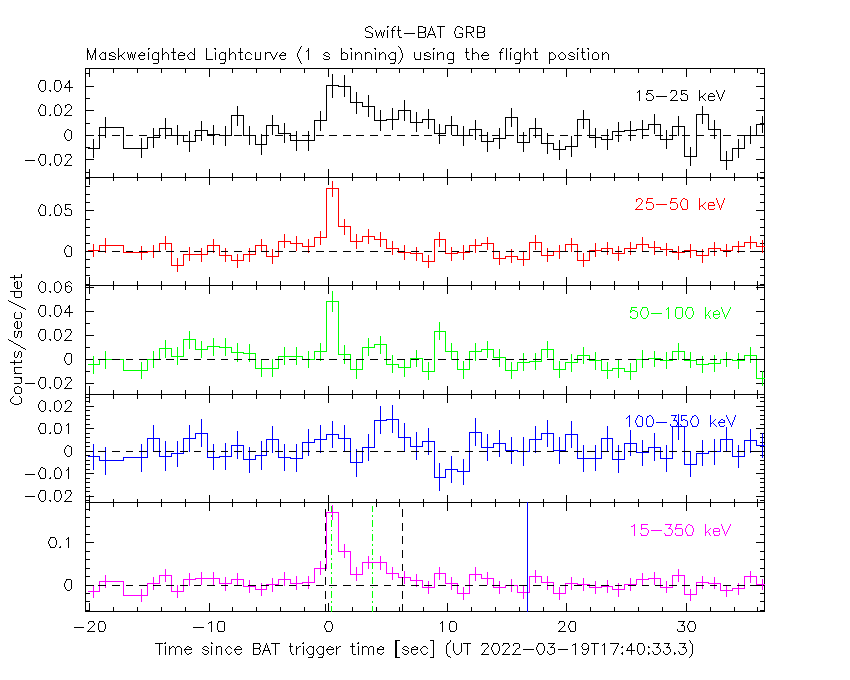
K.L. Page (U. Leicester) and J.D. Gropp (PSU) for the Swift team
At 17:40:33 UT, the Swift Burst Alert Telescope (BAT) triggered and located GRB 220319A (trigger=1098132) (Page et al. GCN Circ. 31769). Swift slewed immediately to the burst. At the time of the trigger, the initial BAT position was 112° from the Sun (9.4 hours West) and 67° from the 98%-illuminated Moon. Table 1 contains the best reported positions from Swift, and the latest XRT position can be viewed at http://www.swift.ac.uk/xrt_positions.
Table 2 is a summary of GCN Circulars about this GRB from observatories other than Swift.
Standard analysis products for this burst are available at https://gcn.gsfc.nasa.gov/swift_gnd_ana.html.
As reported by Krimm et al. (GCN Circ. 31781),
the BAT ground-calculated position is RA, Dec = 218.139, 61.291 deg which is RA(J2000) = 1
The BAT light curve (Figure 1) showed a single-peaked structure with a duration of about 10 s.
The time-averaged spectrum from T-0.36 to T+6.56 s is best fit by a simple power-law model.
The power law index of the time-averaged spectrum is 2.15 ± 0.28.
The fluence in the 15-150 keV band is 2.3 ± 0.4 x 1
The results of the batgrbproduct analysis are available at https://gcn.gsfc.nasa.gov/notices_s/1098132/BA/.
Analysis of the initial XRT data was reported by Gropp et al. (GCN Circ. 31772). We have analysed 16 ks of XRT data for GRB 220319A, from 108 s to 127.7 ks after the BAT trigger. The data are entirely in Photon Counting (PC) mode. The enhanced XRT position for this burst was given by Goad et al. (GCN Circ. 31771).
The light curve (Figure 2) can be modelled with a power-law decay with a decay index of α=1.00 (+0.08, -0.07).
A spectrum formed from the PC mode data can be fitted with an absorbed power-law with a photon spectral index of 2.26 (+0.29, -0.27). The best-fitting absorption column is 2.8 (+1.0, -0.9) x 1
A summary of the PC-mode spectrum is thus:
Total column: 2.8 (+1.0, -0.9) x 1
Galactic foreground: 1.5 x 1
Excess significance: 4.8 σ
Photon index: 2.26 (+0.29, -0.27)
The results of the XRT team automatic analysis are available at http://www.swift.ac.uk/xrt_products/01098132.
UVOT results are not available.

Figure 1. The BAT
mask-weighted light curve in the four individual and total
energy bands. The units are counts

Figure 2. The XRT light curve.
Any data from a crosshatched region are not included in the fit.
| RA (J2000) | Dec (J2000) | Error | Note | Reference |
|---|---|---|---|---|
| 1 |
+61°17'43.3" | 2.1" | XRT-final | UKSSDC |
| 1 |
+61°17'41.9" | 2.2" | XRT-enhanced | Goad et al. GCN Circ. 31771 |
| 1 |
+61°17'26.6" | 1.9' | BAT-refined | Krimm et al. GCN Circ. 31781 |
| Band | Authors | GCN Circ. | Subject | Observatory | Notes |
|---|---|---|---|---|---|
| Optical | Lipunov et al. | 31770 | MASTER Global Robotic Net optical observations |
MASTER | |
| Optical | Belkin et al. | 31773 | Mondy optical uper limit | Mondy | upper limits |
| Optical | Strausbaugh and Cucchiara | 31774 | LCO Optical Upper Limit | LCO | upper limits |
| Optical | de Ugarte Postigo and Jimenez | 31775 | Optical observations from NOT | NOT | |
| Optical | Hosokawa et al. | 31776 | MITSuME Akeno optical upper limits | MITSuME Akeno | upper limits |
| Other | Bizouard et al. | 31785 | GRANDMA observations |
March 25, 2022